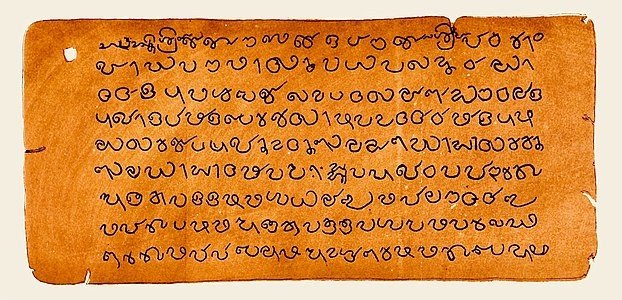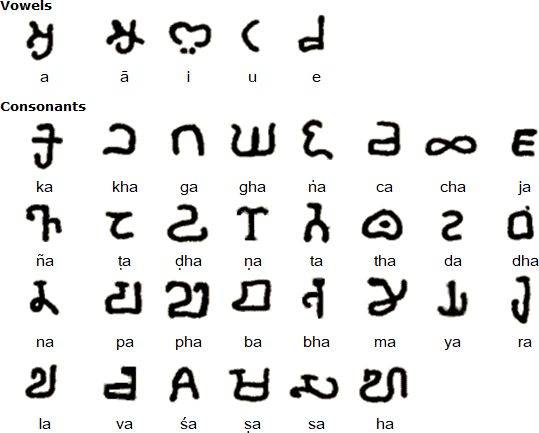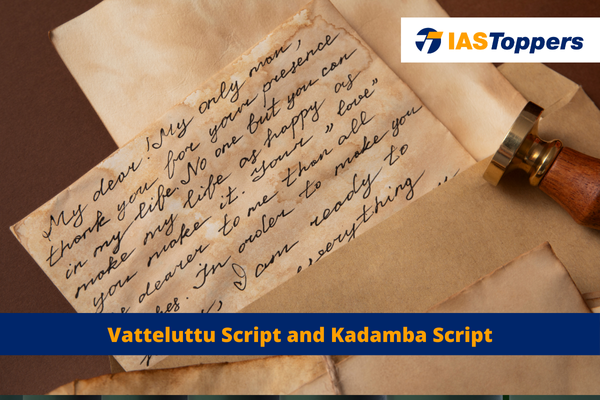Vatteluttu Script and Kadamba Script are ancient Scripts of Southern part of India that has given rise to many other scripts of India. In this article, you will learn about Vatteluttu and Kadamba Script with their definition, features, providing key insights for GS Paper-I Art and Culture section of UPSC IAS Exam.
Table of Content
- About Vatteluttu Script
- Features of Vatteluttu Script:
- About Kadamba Script
- Features of Kadamba Script:
- Conclusion
- Frequently Asked Questions
- Reference
About Vatteluttu Script
- Vatteluttu Script is one of the three primary alphabet systems developed by Tamil people for writing their Tamil Script until the 9th century.
- Vatteluttu Script was also used to write Malayalam until the 15th century and was later converted into the Malayalam script.
- Vatteluttu Script had later developed into the Koleluttu script, used by Christians and Muslims in Kerala.
- The script was also known as Tekken-Malayalam or Nana-mona.
- It was replaced by the Pallava-Grantha script from the 7th century AD in the Pallava court.
- Early Malayalam inscriptions (c. 9th and 12th century AD) are composed mostly in Vatteluttu.
- It gradually developed into “Koleluttu” script in Kerala, as “Malayayma” or “Malayanma” in southern Kerala.
Features of Vatteluttu Script
- Vatteluttu Script’s alphabet follows an abugida writing system.
- Vatteluttu Script has evolved from Tamil-Brahmi Script.

About Kadamba Script
- Kadamba is the first writing system devised specifically for writing Kannada and it was later adopted to write Telugu language.
- Kadamba Script is a descendant of the Brahmi Script.
- Kadamba Script has emerged during the rule of the Kadamba Dynasty in the 4th-6th century AD.
- Alphabet of Kadamba Script is also known as the Pre-Old-Kannada script.
- Halmidi inscription, Talagunda pillar inscription, Gudnapur Inscription, are some of the examples of Kadamba Script.
Features of Kadamba Script:
- Kadamba Script represents the inception of a dedicated writing system for Kannada.
- Kadamba Script evolved into the Kannada-Telugu alphabet by the 10th century CE and was used to write Kannada and Telugu.
- Kadamba Script is related to the Sinhala script.

Conclusion
The ancient scripts of India hold a significant place in the rich cultural and linguistic heritage of the country. These scripts have not only served as the medium of communication and writing but also served as a reflection of the diverse civilizations and intellectual traditions that flourished in ancient India.
They have played a crucial role in preserving and transmitting knowledge across generations from various fields such as literature, philosophy, science, and religion. Both Vatteluttu and Kadamba scripts are integral parts of India’s epigraphical heritage. Their study provides valuable insights into the linguistic, cultural, and administrative practices of ancient South India. Preservation and research efforts continue to uncover their historical significance, ensuring that these ancient scripts are not lost to time.
Ref: Source-1
FAQs (Frequently Asked Question)
What is Brahmi Script?
Brahmiis an alpha-syllabic writing system used in the Indian subcontinent and Central Asia.
What is Kharosthi Script?
Kharosthiis an ancient script utilized in the ancient Gandhara region (present-day Afghanistan and Pakistan) to write Gandhari Prakrit and Sanskrit.
What is Vatteluttu Script?
Vatteluttuis one of the three primary alphabet systems developed by Tamil people for writing their Tamil Script until the 9th century.
Conclusion
The ancient scripts of India hold a significant place in the rich cultural and linguistic heritage of the country. These scripts have not only served as the medium of communication and writing but also served as a reflection of the diverse civilizations and intellectual traditions that flourished in ancient India. They have played a crucial role in preserving and transmitting knowledge across generations from various fields such as literature, philosophy, science, and religion.

